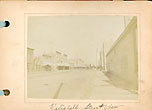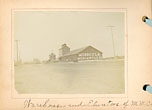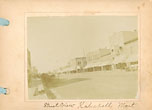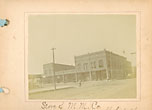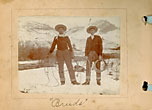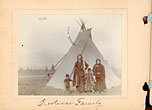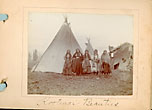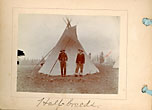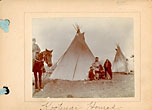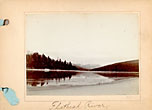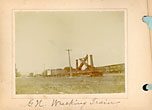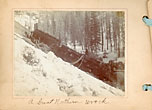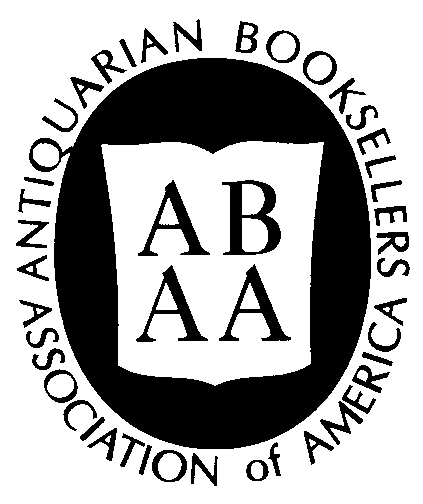Dealer in Rare and First-Edition Books: Western Americana; Mystery, Detective, and Espionage Fiction
Kalispell, Montana Photograph Album Containing Kootenai Native Americans 1895-1904
UNKNOWN PHOTOGRAPHER
Other works by UNKNOWN PHOTOGRAPHERPublication: Unknown photographer, 1895 - 1904,, Kalispell, 1895, 1904
Twenty four images (3" x 4.1/8") mounted on thick cardboard pages each of which is identified. Research identifies the album photographs as being taken between 1895-1904. The images include a Flathead Chief; Kootinai Family; Kootenai Beauties; "Breeds;" Store of M.M. Co. Kalispell; Dam on Stillwater; View on the Whitefish; Warehouse and Elevators of M.M. Co.; Street View of Kalispell, Mont.; Nina and Dick; Looking East from Flathead River; Looking North from Flathead River Bridge; Kalispell Street View; Conrad nat'l Bank - Kalispell; Clyde and His Cayuse; Public Schools, Kalispell; Flathead River; Tame Elk, Flathead Valley, Mont.; On Lake McDonald; A Great Northern Wreck; G.N. Passenger Depot, Kalispell; G.N. Wrecking Train; Kootinai Houses and Half-breeds. Thirteen of the images have a strong contrast with the remaining a very acceptable contrast. The main line of the Great Northern Railway ran through Kalispell from 1892 until 1904. The Flathead Valley was one of the last areas in the trans-Mississippi west to be settled by whites, primarily because of its geographic isolation. Surrounded by rugged mountains and a large lake and characterized by long, hard winters, the valley remained difficult and hazardous to access for decades after the first whites came through the area in the early 1800s. The establishment of the Blackfeet and Flathead Indian Reservations in 1855 insulated the region further. In the 18th and 19th centuries, bands of Kootenai lived at the head of Flathead Lake and hunted and fished in the valley, but they did not have large, permanent settlements in the area. A few trappers and traders passed through the valley in the early 1800s, and around 1812 the Hudson's Bay Company established an outpost, Howse House, near the head of Flathead Lake. Following the Treaty of 1846, which designated land south of the 49th parallel United States soil, various prospectors, trappers, settlers and adventurers passed through the Flathead Valley. But, none are known to have settled permanently, and the area remained virtually unknown to the outside world. While railroad construction crews rushed to lay tracks over Marias Pass and into the Flathead Valley, the towns of Demersville, Ashley and Columbia Falls competed with each other for designation as the railroad division point, their residents knowing that whichever town was chosen would be guaranteed prosperity. Demersville boasted of being the head of navigation, Ashley of its location at the valley's natural outlet to the west, and Columbia Falls of its location where the tracks would emerge from the mountains. None of these towns were chosen, however. According to the generally accepted story, Charles E. Conrad, representing James J. Hill, first tried to purchase land in Columbia Falls but the landowners asked too high a price. Hill instructed Conrad to "go and buy a townsite and I'll build the railroad to it." Conrad subsequently bought part of the homesteads of Reverend George McVey Fisher and several others. Fisher's irrigated timothy hay meadow became the central part of the townsite of Kalispell. According to an 1896 Great Northern publication, the railroad "naturally selected a site that promised to be the commercial centre of this part of the country." The Great Northern Railway rejected Demersville as the division point, reportedly because of its less satisfactory railroad grades and because Kalispell had a better water supply. The Kalispell division point became the headquarters for the railroad between Cut Bank, Montana on the east and Troy, Montana on the west. Land for the new town of Kalispell was purchased by several Great Northern town-site representatives from seven homesteaders. The new town of Kalispell was surveyed and platted in April of 1891, most of the purchases being in the name of A. A. White of Minnesota, a Great Northern Railway town-site man. The layout of Kalispell conforms to that of many other Great Northern Railway towns. The town plat has a "T-town" arrangement, with its main street perpendicular to the railroad tracks and development concentrated on one side of the tracks (the south). Although it was not built until 1903, the Flathead County Courthouse also conforms to a typical railroad-town plan in that it is located as an anchor in the middle of Main Street, on the south end facing north towards the railroad tracks. The town of Kalispell was formally established on March 17, 1891, and its name announced at that time. The name Kalispell (originally spelled Kalispel) is attributed to several sources and is given various meanings. Some said that it was named by James Hill after the Pend d'Oreilles term for the area meaning "upper flat country." Others said it was named after the Indian tribe of the same name, or that it was named for the post established by David Thompson at Thompson Falls called "Kulleyspell." Some believed that Charles E. Conrad named the new town. One of the early Flathead Valley residents, Duncan McDonald, felt that Kalispell was a corruption of the Flathead Indian words for camas prairie. Local historian Henry Elwood says it is believed to mean "camas" or "the prairie above the lake." The Inter Lake newspaper on March 30, 1891, reported that the new town would be called Kalispel, "the liquid Indian synonym for Flathead." The second ""L" was reportedly added to place the accent on the last syllable. The original Kalispell Townsite Company, incorporated January 20, 1891, at St. Paul, consisted of S.G. Comstock and A.A. White (GNRR townsite men), C.E. and W.G. Conrad of Fort Benton (soon of Kalispell), representatives of the Agricultural Press Association, Joseph Coram of Boston, W.P. Clough of the Great Northern Railroad, and others. Clifford and Stannard, real estate and insurance agents of Demersville, originally owned much of the town-site property. On the first day that lots were sold, in April of 1891, buyers crowded around a map placed on a table pointing to the lots they wanted. According to an 1892 newspaper article, "Within thirty days after the plat was placed on the market $300,000 worth of lots were sold." The Missoulian reported that the buyers on the first day were from all over, with residents of Portland, St. Paul and Great Falls the heaviest buyers. (Some of the Great Falls buyers had made fortunes buying lots in that city in 1884). Corner lots sold for as much as $1,250. During that first summer of Kalispell's existence, 23 saloons, six gambling halls, six honky-tonks, two Chinese restaurants, two Chinese laundries and four general stores were reportedly established. On Jan. 1, 1892, the first Great Northern construction train rumbled into Kalispell and the "iron horse...at last snorted in the Garden of Eden of Montana." According to an eyewitness, "Beer and whiskey were as free as the fresh air, and that evening there were many men that were partly sober." Passenger trains began running through Kalispell in August of 1892. At that time, both passenger and freight trains were running daily. In the years 1899, 1900 and 1901 construction in the town boomed, with approximately 130, 200 and more than 300 homes built in those years respectively. In 1901, according to the Kalispell Bee, "many of our residence buildings are artistic and modern, and would be ornaments to a city many times the size of Kalispell." From approximately 1907 until 1910 Kalispell was "on the boom," partly because of the anticipated opening of the Flathead Indian Reservation to the south for white settlement Kalispell served as the railroad division point between Cut Bank and Troy from 1892 until 1904, until the railroad route was resurveyed and the division point moved north to Whitefish. Kalispell's early history is therefore strongly linked to the railroad. In 1892 the railroad constructed service facilities in Kalispell including a depot, a water tank, a freight depot, a 10-stall roundhouse, a section house, an ice house and coal bunkers. Kalispell housed the division road master, the master carpenter, the division master mechanic and the train dispatcher, and the Great Northern Railway payroll was the mainstay of Kalispell's economy. After 1904 no more transcontinental trains ran through town. In 1892, a year after the Great Northern Railway established Kalispell, a stone foundation stood on this corner. Construction soon stalled, however, likely a casualty of the national economic depression known as the Panic of 1893. An 1894 map shows the building still in progress, "to be stores 1st [floor] Lodge Hall 2d." The county court and offices claimed the second story between 1895 and 1903. The Missoula Mercantile moved from quarters on Main Street to occupy the first floor. One of the largest retail and wholesale operations between Seattle and Minneapolis, the Missoula Mercantile sold everything from groceries to wagons. By 1897, its Kalispell branch employed twenty men and covered a 300 mile sales territory, delivering by train as far as Havre. Building additions in 1901, 1903, and 1908, and the installation of large new display windows, provided spacious quarters when the retailer became Kalispell Mercantile in 1911. On New Year’s Day, 1892, the first steam engine pulled into Kalispell on newly laid tracks. Founded as the main line division point for the Great Northern Railway, Kalispell's tenure as a railroad town lasted only until 1904, when the main line moved to Whitefish. By that time, however, the town was already established as a trade and financial center as well as county seat. In 1899, at the height of its "rail glory," the 1892 depot fell victim to an overturned oil lamp. Fire completely destroyed the interior, but the outer brick walls were used in immediate rebuilding. The Conrad banking houses, first those of William and Charles and, after the death of Charles in 1902, those of his wife, Alicia, and William, became very influential in north central and northwestern Montana during the late nineteenth and early twentieth centuries. Owned and personally managed by the Conrad's, they helped finance ranchers, merchants, farmers, and manufacturers-the businessmen whose enterprises were essential to the economic development of these regions. In funding Montana ranching, farming, mercantile, and manufacturing businesses, the Conrad's relied primarily on a network of four single-unit, commercial banking houses: besides the First National Bank of Fort Benton, there was the Northwestern National Bank at Great Falls in north central Montana, the private banking firm of Conrad Brothers (after 1891 the Conrad National Bank) at Kalispell in northwestern Montana, and the Conrad Banking Co. (a private bank that was converted to a state bank in 1911) in Great Falls. To serve the people of Kalispell and its region, Charles and William Conrad established a private bank, known as Conrad Brothers Bank, in a one-room frame shack on the corner of First and Main streets, in May 1891. Charles became the bank's president and William its vice-president, while another brother, Warren, became its cashier. Charles and William supplied the bank's capital of $50,000, as well as deposits of the same amount. On 30 June, Charles opened the Conrad Brothers Bank's doors to the public, and by the end of the year its total assets had grown to $83,512.38 It developed as a regional country bank, meeting the needs of clients in Kalispell and the surrounding countryside. During Charles Conrad's administration, the bank remained solvent and safe, though entrepreneurial. For Conrad this private bank was a stage in an enterprise he intended to convert to a national institution with high standards. In the spring of 1892, with the comptroller of the currency's approval, he obtained a federal charter and changed the institution's name to the Conrad National Bank of Kalispell. He erected a larger ornate structure on the corner of Second and Main streets and moved the bank into it in October. From the outset, Charles and William Conrad were equal stockholders and owned most of the bank's stock. Charles Conrad's policy of safety attracted deposits. During the panic of 1893 and its aftermath the Conrad National Bank gained deposits, at the expense of other banks in Kalispell, such as the Globe National. As depositors became primarily concerned about the safety of banks, many put their money in one of the safest places they knew-the Conrad National. Between December 1893 and August 1895, its deposits rose from $138,099 to $182,157, though a significant part of this gain came from Charles and William Conrad themselves. During the same period, Charles increased the bank's capital from $100,000 to $125,000; he permitted loans to rise from $134,215 to $222,626. Farmers such as George M. Fisher, Kalispell businessmen such as J.L. Cox, and the Conrad's cattle enterprises were among the largest borrowers and paid 12 percent interest on their loans. Deposits were growing but they were not keeping pace with loans, and Charles Conrad hoped to solve by finding new deposits. Under his steady hand, the Conrad National grew and gradually attracted sufficient deposits to cover the demand for loans. By December 1896, the bank had $279,492 in deposits and $235,842 in loans. Deposits were still meeting loan demand four years later. As the volume of deposits and loans grew, so did the Conrad National's total assets, rising from $281,578 in 1893 to $654,202 in 1900. At the turn of the century, Charles Conrad established links with the newly created Conrad Banking Co. in Great Falls. Each photograph is mounted on thick cardboard and each photograph is captioned, ribbon tied, and in very good condition.
Inventory Number: 47839

